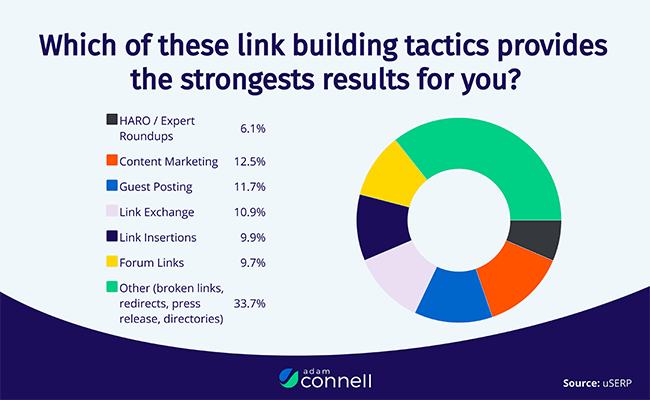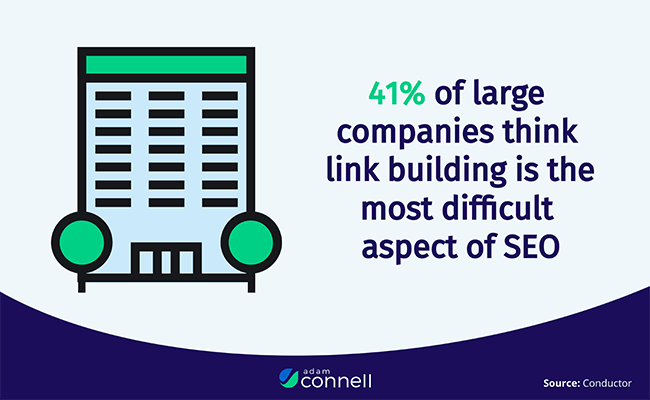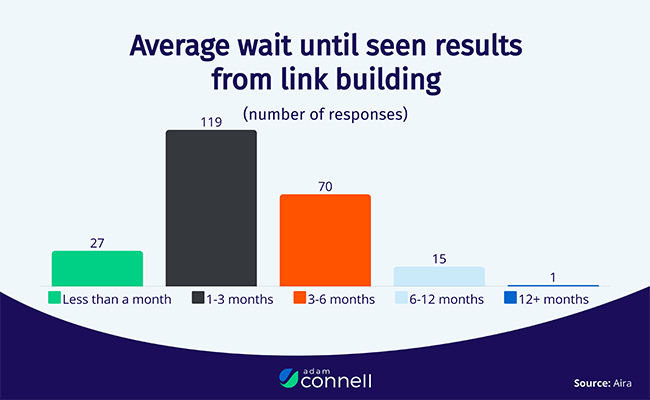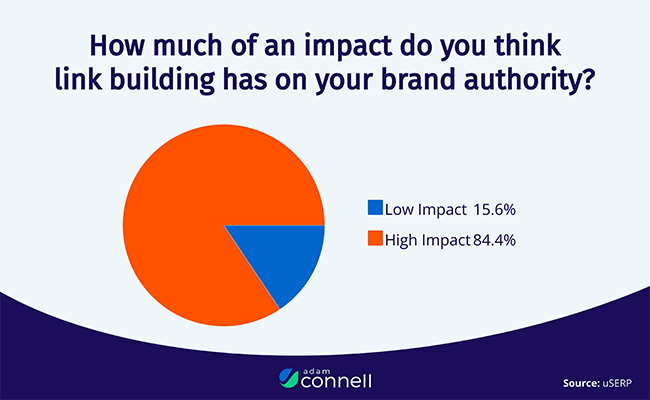28 Link Building Statistics For 2024: Improve Your SEO Strategy
You already know how important SEO is to your marketing efforts.
But what about backlinks? How important are they to your SEO strategy?
In this post, we’ll be taking a deep dive into the latest link building statistics to answer your most burning questions.
Let’s get started with some general link building statistics.
General link building statistics
Want to learn more about the state of link building this year? Here are some key link building statistics that will help you gain a better understanding of the industry.
1. Experts believe link building is the 3rd most important SEO ranking factor after content and keywords

Google continues to use backlinks as an important sign of website authority. As such, most marketing experts are convinced it remains one of the top three ranking factors.
The upshot of this is clear: if you want to outrank the competition, endlessly tweaking your on-page SEO isn’t going to be enough. You need to be investing in off-site SEO and building links too.
Source: Databox
2. Content marketing and guest posting are the most effective link building methods according to marketers

There are lots of different link building strategies businesses can use to acquire backlinks. These include methods like broken link campaigns, sharing infographics, and submitting your site to resource pages.
However, the most effective method according to most marketers is content marketing. With content marketing. you ‘earn’ backlinks naturally by creating awesome content that others want to link out to. 12.5% of respondents in a recent survey said this provided the strongest results in their link building campaigns.
Guest posting—a link building method in which you perform email outreach to other bloggers in your niche, then write and submit a post on their site—was rated the second most effective, with 11.7% of respondents saying it generated the best results.
Source: uSERP
3. Almost 40% of businesses spend between $1000 and $5000 on link building each month

38.43% of businesses have a link building budget in this price range, making it the most common spending bracket. A further 34.14% spend up to $1,000 per month on link building, and 20.29% spend between $5,000 and $10,000/month. Only a little over 7% spend over $15,000 per month on backlinks.
Where does that money go? Well, there are various costs involved in link building, such as the costs of creating ‘link magnet’ content, link placements, outreach services, etc.
Many businesses also choose to hire third-party link building services. These are typically priced based on quality. Editorially placed contextual backlinks are more expensive, and the higher the domain authority of the linking site, the more you’ll pay. Expect to pay upwards of $300 per worthwhile backlink on an authoritative site.
Be cautious about purchasing links that seem very inexpensive as these are often spammy links in bad neighborhoods that can land you penalties and have a negative impact on SEO.
Source: uSERP
4. On average, top ranking results on Google have 3.8 times more links

This goes some way towards proving what many marketers already believe: backlinks are a key ranking factor. Correlation doesn’t necessarily equal causation, but in this case, it seems clear that pages with more links stand a better chance of reaching the top spots in the SERPs.
Source: Backlinko
5. 41% of large companies think link building is the most difficult aspect of SEO

And they’re not wrong! Link building is notoriously difficult compared to other aspects of SEO. The main reason for this is that you have limited control over the success of your link building campaign—you’re completely reliant on other site owners agreeing to link to you.
This isn’t the case for other branches of SEO. With on-page and technical SEO, your results are directly linked to the work you put in. But with link building, even the best well-laid plans can lead to zero external links if you don’t get lucky.
Source: Conductor
6. Approximately ⅔ of web pages have no backlinks at all
Despite the importance of backlinks as a ranking factor, the majority of pages on the internet don’t have any. This is good news and bad news.
On the one hand, it highlights how difficult link building can be. But on the other hand, the fact that the majority of your competitors are unlikely to have any links makes it easier for your content to rise to the top of the SERPs if you build them!
Source: Ahrefs
Link building strategy and practices statistics
Link building can be a tricky business, and it’s not easy to come up with a clear strategy for success. The link building statistics below can help you learn more about popular strategies and practices used by marketers and businesses.
7. Over 40% of marketers believe content marketing is the best way to generate passive links
Many marketers choose to take a more passive approach to link building. Rather than actively trying to build new links, these marketers hope that they’ll accrue/earn links naturally by creating content.
There’s a lot to be said for this approach. It’s the only real true white-hat approach to link building as other, more active link-building methods go against Google’s webmaster guidelines as they’re essentially deliberate attempts to artificially improve your search visibility.
Source: uSERP
8. Content marketing campaigns aimed specifically at generating links was the most used link building strategy in 2021

The Skyscraper technique is a common strategy used in these kinds of content marketing campaigns. The idea behind it is to find high-ranking content that has a ton of backlinks, create a much better version of it, then reach out to sites that are already linking to it and ask them to link to yours instead.
Source: Aira
9. 89% of marketers produce content with the goal of building links

Infographics, listicle posts, and skyscraper posts are some of the content types that attract the most links. If you’re aiming to produce content with link building in mind, focus on this type of content.
Source: Aira
10. 54% of businesses generate links through competitor analysis and link targeting
With so many SEO tools out there, it’s easier than ever to spy on your competitors. With tools like Ahrefs and SEMRush, you can easily view the backlink profile of competitor pages. And once you know who’s linking to your competitors, you can target those same links in your own link building campaigns.
Source: Aira
11. Over 50% of marketers believe it takes 1 to 3 months to see link building results

SEO is a long-term marketing strategy. It takes time for Google to crawl and index new links, so don’t expect to see results straight away. The majority of marketers think that it takes a few months before they start to take effect.
Source: Aira
12. Long-form content generates 77.2% more links than shorter articles
People prefer to link out to content-rich, in-depth sources of information, which is why long-form content generates more links than short posts. The upshot of this is clear: if you want to build links, focus on writing longer posts that cover topics in detail.
Source: Backlinko2
13. ‘What’ and ‘Why’ posts generate around 25% more links than ‘How-to’ posts
Interestingly, posts that answer ‘what’ and ‘why’ questions tend to generate more links than tutorial posts. Factor that into your SEO and content marketing strategy and make sure you’re including these types of posts in your content mix.
Source: Backlinko2
14. Almost 50% of top-ranking pages have reciprocal links
Reciprocal links are two-way links. In other words, if site A links out to site B, and site B also links out to site A, that’s a reciprocal link. SEOs have often worried that Google might not like reciprocal links as they’re often the result of black hat tactics like link exchanges, but this stat shows they’re surprisingly common.
Source: Ahrefs3
15. Around 54% of marketers believe no-follow links are valuable to their backlink profile

Against conventional wisdom, the majority of marketers think no-follow backlinks are valuable. Links marked as nofollow are ignored by search engines, which means they don’t pass any link juice. However, they can help you to attain a more natural-looking backlink profile, which can indirectly help your SEO efforts.
Source: uSERP
16. Only 8.5% of link building cold emails generate results
That seems pretty low, but most link-building outreach campaigns involve sending emails en-masse to dozens or even hundreds of recipients at once. Therefore, even if only 8.5% generate results, a single cold email campaign can still land you a bunch of new links.
Source: uSERP
17. 65% of marketers think domain authority is the most important factor to consider when determining backlink quality
A single link from a high-authority domain can affect your ranking power more than dozens of low-quality links on low-domain sites. However, authority isn’t the only factor that matters. The relevancy and traffic of the referring page matter too.
Source: uSERP
Link building effectiveness statistics
Everyone seems to have different opinions when it comes to the importance and effectiveness of link building. Here are some link building statistics that will give you an idea of the impact a good backlink profile can have on your site’s rankings.
18. Around 58% of businesses believe link building has a big effect on their SERP rankings

There’s no doubt that link building has some effect on search engine rankings, but it’s still unclear how much sway they hold. According to uSERP, almost 60% of marketers believe link building has a big impact on their search engine rankings.
Source: uSERP
19. 56% of businesses believe both the quality and quantity of links impact rankings

Marketers are often torn when it comes to link quality and quantity. Some believe that the more backlinks you have the better. Others think that a few high-quality backlinks can take you a long way. However, the most common opinion shared by 56% of marketers is that both quality and quantity have an impact on ranking, so taking a balanced approach is probably the best option.
Source: uSERP
20. 63% of businesses believe buying links has a positive effect on rankings
Buying backlinks is something that has the SEO world divided. Some experts claim that purchased links don’t pass as much link juice as high-quality organic links, and this leads some marketers to steer clear of them altogether.
However, many businesses are more than happy to take advantage of paid links to boost their search engine rankings. Around 63% of marketers believe buying links has a positive effect on ranking.
Those rankings increase traffic and that traffic generates leads.
Source: Aira
21. 44% of marketers are positive that link building delivers results

Link building is a commonly used SEO tactic, but sometimes it can be hard to keep track of the results of your campaigns. It’s not easy to know what factors impact increases in ranking power and you can’t always be sure which links, in particular, helped your rankings improve. Despite this, 44% of marketers are certain that link building provides positive results for their overall marketing strategy.
Source: Aira
22. 85% of marketers feel that link building is important for brand building

For many businesses, link building isn’t just about gaining link juice and improving rankings. It’s also about building brand authority and establishing connections and exchanging links with other well-known brands. According to a uSERP study, 85% of marketers think that link building is key for building brand authority and awareness.
Source: uSERP
23. 85% of marketers believe link building will still be an important ranking factor in 5 years’ time
Link building has been a part of SEO strategy for many years. In that time, best practices have changed, and what constitutes a high-quality link has also evolved. According to marketing experts, link building will continue to form a core part of SEO in years to come too. Around 85% believe that it will still be an important ranking factor in 5 years.
Source: Aira
Link building costs statistics
Although it’s technically against Google’s terms of service, many businesses still pay in order to build their backlink profile. Here are some statistics related to the cost of link building in 2023.
24. On average paid backlinks costs $360
Purchasing backlinks is one of the easiest ways to build your backlink portfolio. Despite many businesses having reservations about this practice and Google being dead set against it, it’s still a popular method for businesses. According to Ahrefs, the average paid backlink costs businesses around $360 to secure.
Source: Ahrefs
25. And high-quality links can cost over $1500 in some cases
Although $360 is the average cost of a backlink, links from high-quality sources such as high-authority sites and publications can cost you a lot more. According to Siege Media, a single high-quality backlink can cost as much as $1500. Siege also found that some backlink campaigns cost businesses as much as $20000 a month.
Source: Siege Media
26. In house marketing teams use as much as 10% of their budget on link building, on average
Much of the cost of link building comes from outsourcing efforts to expert teams. However, even marketing teams that run link building campaigns spend a sizable portion of their budget on link building. According to Aira, businesses that manage their marketing in-house spend around 10% of their overall marketing budget on their link building campaigns.
Source: Aira
27. Over 40% of businesses believe the cost of link building will increase in the future
As we can see, link building is already a very expensive SEO practice for some businesses. However, the cost of link building is only set to increase based on the predictions of expert marketers.
According to an Aira survey, over 40% of businesses believe that link building costs will continue to rise as the industry becomes more competitive.
Source: Aira
28. 35% of businesses outsource when it comes to link building and SEO
If Google has their way, backlink acquisition would be something that happened naturally for high-quality websites. However, gathering links is actually extremely competitive, and brands and businesses have to spend a lot of time and money building their backlink portfolio.
As a result, many businesses choose to outsource their link building tasks to expert agencies and freelancers. According to Social Media Today, just over 35% of businesses outsource their link building efforts.
Source: Social Media Today
Final thoughts
And that concludes our roundup of 28 enlightening link building statistics and trends. Hopefully, these link building stats will help you to improve your SEO strategy in the year ahead.
If you’d like to learn more about SEO, be sure to check out my post on SEO statistics & trends.
Finally, if you’d like to hone your link building skills, check out these posts:
- A Quick Guide To Crafting Guest Post Pitches That Convert
- How One SaaS Brand Wasted An Outreach Email (And What To Do Instead)
Or if you’d like read up on more marketing stats, check out these posts:
